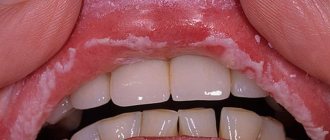Pharyngitis is an inflammatory process that forms on the back wall of the larynx and affects the mucous membrane, as well as deeper layers, tissues of the soft palate and lymph nodes. The acute form of pharyngitis can develop into chronic if the patient does not seek help from a doctor and self-medicates.
Since the pathological process in the larynx is caused by the spread of pathogenic bacteria, the risk of developing pharyngitis increases in people with a weak immune system and in those who suffer from ENT diseases or are predisposed to them.
How dangerous is pharyngitis and how does it manifest itself? Which doctor should I contact and how to treat the disease? We will answer these and other questions in this article.
Reasons for the development of pharyngitis
Experts believe that the peak development of pathology occurs at the end of winter and the beginning of spring, since at this time the human immune system is especially susceptible to colds. Often in the spring season, a lack of vitamins and microelements in the human body leads to the appearance of vitamin deficiency, the body weakens and creates an excellent environment for the development of pathogenic bacteria. Inflammatory processes are also possible: both separately and against the background of the underlying disease.
The first signs of pharyngitis and its further treatment may differ depending on the stage of the pathology, gender, age and general health of the patient.
We include the following as the main reasons for the development of pharyngolaryngitis:
- hypothermia, eating too cold foods;
- deformation of the nasal septum;
- strains of microorganisms that cause the development of chlamydia, candidiasis, whooping cough, scarlet fever, measles;
- adenovirus, influenza virus;
- streptococci, staphylococci, pneumococci;
- sinusitis, tonsillitis, caries, rhinitis;
- difficulty breathing through the nose;
- pathologies of the gastrointestinal tract: reflux, heartburn, hernia;
- abuse of bad habits;
- regular high loads on the vocal cords;
- polluted, toxic air;
- hormonal disorders and endocrine pathologies (diabetes mellitus, obesity, hypothyroidism, etc.);
- tonsillectomy, which was performed on the patient previously;
- infectious diseases in chronic form;
- weakened immunity.
What causes throat cancer in men?
The growth of malignant neoplasms in the larynx is provoked by:
- smoking . Often in smokers, oncology simultaneously affects not only the larynx, but also the lungs and the musculoskeletal system. All due to the high content of carcinogens in tobacco smoke. Therefore, smokers with significant experience should think about it;
- gender predisposition. Peculiarities of the hormonal background of men provoke the active development of the human papillomavirus on the mucous membrane of the nasopharynx;
- natural degenerative changes . With age , the chance of epithelial cells degenerating into atypical ones increases;
- working conditions. Men most often work in hazardous industries. In metallurgy, oil production and coal mining, and chemical production, the concentration of carcinogens (substances that cause cancer) is very high. And even modern means of protection cannot completely prevent the development of the disease.
Throat cancer (photo of the terminal stage in the figure below) can provoke ailments: pachyderma, papilloma. With them, malignant tumors affect different parts of the throat and vocal cords.
Symptoms of pharyngitis
The first signs of the disease may differ depending on the type of pharyngitis. They are both local and general in nature. But there are common signs that are characteristic of any type of pharyngitis: sore throat, bad breath, stuffy ears and difficulty swallowing. With an active inflammatory process, an increase in body temperature above 38° can be observed - this is how the body fights a foreign infection. General signs: sweating, poor appetite, weakness, dizziness, fatigue, fever, chills. Some complain of pain and noise in the ears, and discomfort when exposed to loud sounds.
- During acute catarrhal pharyngitis, swelling and redness of the mucous membranes of the larynx appears. Also, red follicles may form on the back wall of the throat, and clear and slightly cloudy mucus may accumulate. There is swelling and redness of the tongue.
- In the purulent form of acute pharyngitis, ulcers with an accumulation of purulent masses appear on the surface of the posterior pharyngeal wall.
Symptoms of laryngeal cancer
There are no common signs for laryngeal cancer
, they are determined by the parameters of the tumor, its position, and growth rate. At the very beginning, it is sometimes difficult to notice a malignant formation.
Common symptoms of throat cancer
relate:
- pain in the throat, including when swallowing,
- sore throat,
- frequent bronchitis,
- hoarse voice,
- changes in the shape of the neck (swelling),
- a sharp decrease in body weight,
- discomfort in the ears.
Acute pharyngitis
Acute pharyngitis can occur independently, and can also be accompanied by acute inflammation affecting the upper respiratory tract: rhinitis or inflammation of the mucous membranes of the nasopharynx.
Depending on the cause of development, acute pharyngitis occurs:
- Viral – most often caused by rhinovirus;
- Bacterial – caused by streptococci, staphylococci and pneumococci;
- Fungal – source of the inflammatory process – Candida;
- Traumatic - caused by damage to the pharynx and larynx: the throat was scratched by a sharp bone or burned by boiling water, severe stress on the ligaments;
- Allergic – occurs when inhaling allergens or irritants, such as tobacco, exhaust fumes or dusty air.
Chronic pharyngitis
According to the depth of damage to the pharyngeal mucosa, chronic pharyngitis is divided into: catarrhal, hypertrophic and atrophic forms.
- Chronic catarrhal pharyngitis - there is slight swelling of the tissue layers of the pharyngeal mucosa. Individual areas are sometimes covered with clear or slightly cloudy mucus. It develops as a result of acidic gastric contents entering the throat, for example, in the case of a hiatal hernia. Therefore, catarrhal chronic pharyngitis is a consequence of the development of diseases of the gastrointestinal tract.
- Chronic hypertrophic pharyngitis is a significant severity of swelling of the mucous membrane. Additionally, thickening of the uvula and swelling of the soft palate are observed.
- Chronic atrophic pharyngitis is characterized by some thinning of the lining of the pharynx. They are usually pale pink, sometimes shiny varnished. Some of their areas become covered with crusts, viscous mucus and pus.
Any type of chronic pharyngitis develops due to the fact that the acute form of the disease was not cured in time and developed into a more serious form. Chronic pharyngitis also appears as a consequence of rhinitis, sinusitis, deviated nasal septum, nasal polyps - that is, when nasal breathing is difficult for a long time. In addition, long-term use of vasoconstrictor drops also leads to the appearance of chronic pharyngitis.
How does pharyngitis manifest and progress in children?
Children suffer from pharyngitis more severely than adults. This especially applies to babies under one year old. Swelling of the mucous membrane can cause signs of suffocation; the pain that accompanies the disease reduces the child’s appetite. Often, a baby’s body temperature can reach 40°. The most difficult thing in this situation is that a small child cannot say what hurts.
Incorrect treatment can lead to irreparable consequences for a small, fragile organism. Therefore, at the first signs of pharyngitis, consult a doctor immediately.
Sore throat and pharyngitis: what is the difference?
The general condition of the patient with acute tonsillitis or tonsillitis can be confused with the symptoms of pharyngitis. If the disease is diagnosed incorrectly, then treatment of pharyngitis in adults will not have any effect. And the acute form of the pathology can develop into a chronic one.
Unfortunately, many patients self-medicate and start using medications without a doctor’s specific prescription. This is extremely contraindicated! It is better to take care of your health in time and seek help from an experienced otolaryngologist.
It is important to remember that during pharyngitis, the larynx becomes inflamed, and during tonsillitis, the tonsils become inflamed. During a sore throat, it is always painful to swallow, and the pain intensifies even more when eating food. With pharyngitis, the opposite happens - while eating warm food or warm drinks, the sore throat decreases.
During the development of a sore throat, there is no cough or sore throat, only a sore throat and sometimes the formation of a white coating. With pharyngitis, there is a sore throat, as well as noise, pain, or congestion in the ears. The difficulty in distinguishing between these two diseases is further complicated by the fact that one patient can simultaneously develop both pathologies, since they are caused by the same pathogen.
Forecast
If the diagnosis was made correctly and treatment started in a timely manner, the five-year survival rate of patients diagnosed with stage three laryngeal cancer is about 50-80%. The patient needs to remember that this depends not only on many of the above factors, including the experience and level of professionalism of the doctor, technical and medicinal support of the clinic, but also on the patient’s own desire to be cured. Carefully following the doctor’s recommendations before, during and after treatment is no less important in achieving a positive result in the fight against the disease.
| More information about treatment at Euroonco: | |
| ENT oncologists | from 5100 rub. |
| Chemotherapy appointment | 6900 rub. |
| Emergency oncology care | from 12100 rub. |
| Palliative care in Moscow | from 44,300 rubles per day |
| Radiologist consultation | 11500 rub. |
Book a consultation 24 hours a day
+7+7+78
Diagnosis of pharyngitis
Detection of all types of pharyngitis begins with a visual examination of the larynx using a special device and taking an anamnesis. A throat swab is also taken for examination to test for diphtheria.
Other types of diagnostics:
- Cultural examination - inoculation of taken materials on a nutrient medium.
- Rapid diagnosis - identification of streptococcal antigen in throat swabs.
- Immunoserological diagnosis - the method is used in case of streptococcal infection.
Laboratory research:
- Complete blood count – exclusion of blood diseases, infectious mononucleosis;
- A general urine test helps rule out kidney disease (glomerulonephritis).
Depending on the symptoms of the disease, as well as the condition of the larynx, the presence or absence of cough, fever, plaque on the tonsils and soreness and increased size of the lymph nodes, additional consultations with other specialists may be necessary: an endocrinologist, a cardiologist, an allergist.
We care about your health
Tonsillitis is one of the most common diseases. Infections of a viral or bacterial nature enter the respiratory tract (often one of them is joined by another), causing an inflammatory process. A surge in tonsillitis is most often observed in the spring and winter, when many people have a weakened immune system. Also, this disease can develop against the background of existing foci of infections in the body, for example, with dental caries, periodontal disease, sinusitis and others.
Tonsillitis is transmitted mainly by airborne droplets, pathogens: staphylococci, streptococci, fungi, bacilli.
Tonsillitis can have both acute (called sore throat) and chronic forms. Acute tonsillitis most often occurs as a result of an exacerbation of the chronic form, when a person with reduced immunity could, for example, become hypothermic.
Symptoms of tonsillitis
Compared to chronic tonsillitis, acute tonsillitis occurs in a more severe form: the body temperature can rise to 40 degrees, the patient feels a very strong pain in the throat, and it is difficult for him to swallow. The tonsils are swollen and enlarged, with the presence of purulent plugs. Patients feel headache, weakness, and their lymph nodes are enlarged.
Depending on the type of sore throat, which can be lacunar, herpetic, catarrhal, follicular, etc., ulcers, follicles, and a film called plaque form on the palatine tonsils.
With chronic tonsillitis, the temperature can rise to 38. The patient has a light coating on the palatine tonsils, and the tonsils themselves look enlarged and reddened. A person feels weakness, muscle pain, and aching joints.
Chronic tonsillitis is characterized by stages of remission and exacerbation. During the period of remission, the focus of infection is passive, and the person is not bothered by unpleasant symptoms. But as soon as one becomes hypothermic (especially with reduced immunity), he immediately begins to feel an unpleasant sore throat, pain when swallowing, cough, fatigue, poor general health and lack of appetite. The patient's lymph nodes may become inflamed.
Chronic tonsillitis is a long-term inflammation of the pharynx and palate. Its simple form has only a local symptom: sore throat. But if the picture is complemented by persistent lymphadenitis of the neck, changes in the functioning of the heart and high temperature, then this is already a toxic-allergic form.
Chronic tonsillitis has several stages: compensated, when the source of infection is not active, and decompensated, when exacerbation occurs due to repeated sore throats, inflammation of the ear and nose.
Tonsillitis (tonsillitis) - what inflammation looks like (photo of the disease)
Photograph of the throat with purulent sore throat
Photo - throat with follicular sore throat
Catarrhal sore throat - photo
Photo - lacunar tonsillitis
Possible complications of tonsillitis
Like many other diseases, tonsillitis is dangerous due to its complications . These include, first of all, rheumatism. After suffering from a sore throat, a person may feel severe aching in the joints and an increase in temperature.
In second place, as a rule, are cardiovascular diseases. Interruptions in heart function, shortness of breath, tachycardia are sure signs that a sore throat has caused complications.
Another unpleasant symptom after tonsillitis is swelling and tenderness of the lymph nodes, which have become infected from the tonsils. This is lymphadenitis.
The infection can also spread from the tonsils to the surrounding tissues of the upper respiratory tract, leading to pain when swallowing. And this disease is a complication of tonsillitis and is called paratonsillitis.
It should be noted that more than a hundred diseases are known that arise as a result of complications after acute tonsillitis. These include a variety of kidney, eye, skin and thyroid diseases.
Diagnosis of tonsillitis
It begins, of course, with an examination by a doctor, who determines whether the tonsils and adjacent tissues are swollen and red, and whether the ear and cervical lymph nodes are inflamed. The patient is sent for a general blood test.
Before prescribing treatment to the patient, the ENT doctor determines the nature of the inflammatory process: in what form does tonsillitis occur - chronic or acute, the type of inflammation (purulent, catarrhal), is the sore throat primary or secondary, what is the causative agent (this is determined in the laboratory - a culture is done from the throat ).
Treatment of tonsillitis - specifics of therapy
In the treatment of tonsillitis, both conservative methods and surgical intervention can be used. Treatment methods depend on the specifics of the disease.
For chronic tonsillitis, if necessary, antibiotics are prescribed in tablets, and for sore throat they are often administered intramuscularly. Local treatment is also carried out: purulent plaque on the tonsils is removed, the lacunae are washed with antibacterial solutions, physiotherapy and a course of vitamins with immunomodulators are prescribed.
In case of acute tonsillitis, it is recommended to irrigate the oral cavity with antiseptic solutions, rinse, treat the tonsils with iodine-containing preparations (if there are no allergic reactions to iodine), inhalations, and resorption of antibacterial tablets are useful. You should also drink a lot (weak teas, fruit drinks, juices, rosehip decoctions, etc.), take antipyretic and painkillers.
Acute tonsillitis is not recommended to be treated with antibiotics, because they reduce local immunity. But if the form of the disease is more severe, then the patient requires mandatory bed rest and antibiotic therapy. However, the prescription of antibiotics should be preceded by an analysis of the results of culture in the pharynx area, which will identify the causative agent of the infection. It is recommended to include in the course of treatment drugs that enhance immunity, as well as general strengthening and anti-inflammatory drugs. Physiotherapy will also be useful.
If a person suffers from tonsillitis more than twice a year, has complications from this disease, and conservative treatment does not bring the expected results, then removal of the tonsils may be recommended. There are many modern methods of performing this operation (infrared laser, ultrasound, biopolar, radiofrequency ablation and others), but many consider the cold plasma coblation method to be the most effective and gentle. However, it should be remembered that the tonsils are the first protective barrier that stops and disarms pathogenic bacteria . But in many cases (especially after frequent colds), the tonsils stop performing their functions and themselves become a source of infection, causing serious complications. In this case, it is better to remove them.
Treatment of tonsillitis (tonsillitis) at the Medkvadrat ENT center in Moscow, Kurkino and Khimki.
Treatment methods for pharyngitis
Treatment must be comprehensive. The patient is prescribed medications that will relieve pain and reduce inflammation. It is also important to adhere to a special diet and exclude from the diet foods that irritate the mucous membrane of the throat and bring even more discomfort: alcoholic beverages, spicy and salty foods, sour foods, carbonated drinks.
Drug therapy
Depending on the clinical picture and general condition of the patient, the doctor may prescribe antihistamines, antitussives and antiviral medications. Lozenges/lozenges are used to relieve pain.
In some cases, they resort to the use of antibiotics. They can only be taken as directed by a doctor.
Local impact
Rinsing with special solutions also has a good effect on the inflammatory process and redness of the larynx. They have a gentle effect, relieve pain and improve the general condition of the patient.
To diagnose and identify the disease, you need to consult an otolaryngologist. At the city clinic, you can contact your primary care physician, who will issue a referral to an ENT specialist. However, this takes time. You often have to wait 2 weeks for an appointment with a doctor. In some cases, this is simply impossible, since it is necessary to quickly conduct an examination and prescribe treatment before the situation becomes critical.
Therefore, we recommend contacting the Medunion medical clinic. We employ practicing otolaryngologists, and you don’t have to wait several weeks for appointments. Sign up today for a time convenient for you, and get tested tomorrow.
Patients choose us because we provide the service of a specialist coming to your home if you cannot come to the clinic on your own. You can also take samples directly at home.
The cost of an initial consultation with an otolaryngologist in Krasnoyarsk at the Medunion clinic starts from 1,300 rubles. You can sign up on the website or by calling 201-03-03.
How much does treatment for squamous cell carcinoma of the larynx cost in Israel?
The final cost of treatment for any form of laryngeal cancer is determined based on the scope of previous diagnostics, the nature of the therapy performed and the duration of rehabilitation. But you can plan your trip budget in advance by simply ordering a free financial audit of the cost of treatment in any of the chat windows from an online consultant. This official document contains a list of clinics specializing in the treatment of laryngeal cancer in Israel, a detailed description of prices for diagnostic and therapeutic procedures. The consultant will also create an individual medical program for you. It contains a list of studies to be completed in the clinic, as well as possible treatment methods, and an approximate price. In the comfort of your home, you can calmly get acquainted with possible offers from clinics, choose the most optimal one for yourself and calculate your travel budget.
- 5
- 4
- 3
- 2
- 1
(3 votes, average: 5 out of 5)









